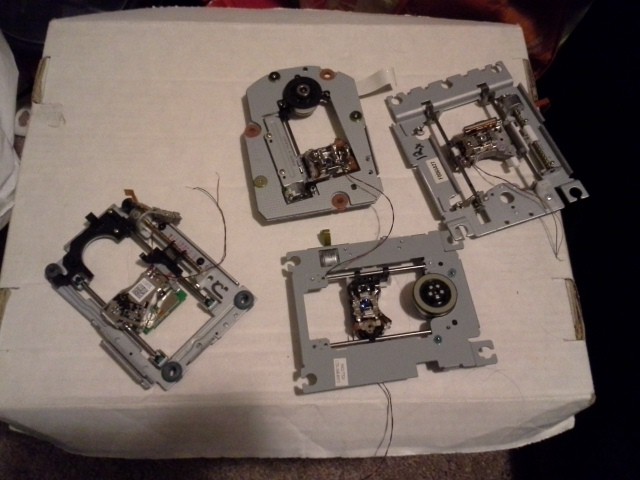Check out the discussion between @DeepSOIC and @johnowhitaker over at #Mini Laser Cutter, and check out #Measuring DVD-RW laser... two methods for determining how much power to give your laser before burning it out like I did countless times (Update 3-29-16: see below)!
3-29-16: Revisiting this project... it's about time I actually have a 2-axis system like the Mini Laser Cutter, linked above, so maybe I can eventually start toner-lasering some friggin' PCBs!
(OMG, it just occurred to me that once this thing's up and running, I could actually make a PCB to drive it, to replace the breadboarded-system I'd been using!)
Anyways, one mental-hurdle, which has been taken-care-of in the links above, is that of determining how much power to supply to the laser. I remember having had a "graveyard" of diodes I'd overpowered, but this is the first time I dug through the box in quite a while, and low-and-behold look at this graveyard! I didn't realize I'd killed *that* many!

A great/unrelated trick I'd learned upon rereading that this time 'round: Use batteries (or capacitors) to drive different circuits, that way when you connect your single-ended 'scope probes, it actually can measure across *any* *two* points in the (battery-powered) circuit. It's like using two separate probes in "Additive" mode (with one inverted), or like having a differential-input probe... Awesome!
My next mental-hurdle is in using the DVD-RW's laser (and optics) in a system like @johnowhitaker's #Mini Laser Cutter. He used a separate laser and optics which were more conducive to greater-distances... so I'm not sure whether I'll be removing the focus-lens and replacing it with a different one, or whether it's even possible to use the focus-lens to get more than 1-2mm of distance to the surface I'd like to etch/burn/cut/melt... I think it's a matter of the lens's focal-point, so probably not.
Basically, I guess, I'm just reactivating this part of my brain which's been shut down for a while. *Of Course* the focal-point won't change with-respect-to the focusing-lens... duh. But, now I'm remembering... one of my earlier experiments (in an earlier log) fed the (really wide) collimated output from the drive's optics (with the focussing coils/lens removed) into a regular-ol' magnifying-glass, giving a focal point several inches away AND being of such a shallow angle that slight displacement from the exact focal-point had very minor effect on the power-per-area... Right! It's coming back!
OK, lemme rephrase that last bit, since that's been an ongoing mental-hurdle lately...
- Replace the focusing-lens with a regular-ol' magnifying glass
- Reap the Rewards!
- The surface needn't be so close to the laser (easy-access)
- The surface needn't be *perfectly* level
- Some amount of play is probably OK, due to the (comparatively) shallow angle of the light entering the focal-point.
- (FYI, these lists don't work too well in my browser)
Sheesh, that's not nearly as complicated as I'd built-up in my mind over the past several days... including some amount of certainty I'd need to have an "auto-focus"/"bed-levelling" system to use the laser-optics already on the drive... even contemplating use of the photo-diodes used in the drive to adjust the focus... Dang, WTF brain?
ONE MORE TIME> BRAIN GET IT STRAIGHT:
1: REMOVE FOCUS LENS/MAGNETICS
2: TAPE MAGNIFYING GLASS (fergoddsakes tape)
3: QUIT THINKING SO HARD.
4: (set *really low* max-current on laser, and only *if* that's not enough, ONLY THEN use ONLY-SLIGHTLY-LESS-SIMPLE method for determining how much it can be bumped-up-to safely).
5. QUIT THINKING SO HARD.
 Eric Hertz
Eric Hertz
Discussions
Become a Hackaday.io Member
Create an account to leave a comment. Already have an account? Log In.